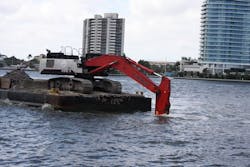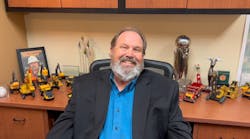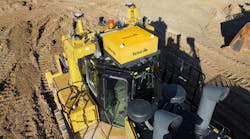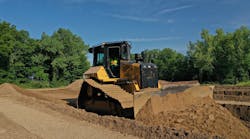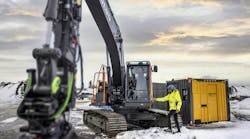For almost as long as he can remember, David Logan has been involved in construction. The son of Murray Logan, owner of the self-named West Palm Beach-based construction company, he can recall going to one of his dad’s projects as a 10-year-old boy and being responsible for turning on pumps for hammers for him. That gave David a taste for construction that never left him.
Editors note: This article was contributed by Topcon and originally ran in Grading & Excavation Contractor.
Today, he and his brother Andy, as co-owners of Murray Logan Construction (MLC), have continued their dad’s commitment to making the company one of the area's premier heavy marine construction companies. Currently involved in the largest project they’ve ever undertaken—heading up a major upgrade of the iconic Palm Beach Town Marina—the company was faced with a challenge: finding a way to accurately, but efficiently, excavate the floor of the marina basin. It was a challenge that was met with through the addition of GPS-based machine control systems in the trio of excavators performing the work. The solution proved so impactful that, when a subcontractor was brought in to supplement MLC’s fleet, they too, added the system to their machines. Success, it would seem, is contagious.
The $38 million project at Palm Beach Town Marina was approved in response to a call for facilities better equipped to handle larger vessels. Keeping in mind that this is Palm Beach, a city with more than 30 people on Forbes’ list of the world’s richest people, larger vessels meant those 275 feet in length or better. According to David Logan, the trend for marinas like the one at Palm Beach is for bigger vessels, so the town is simply reacting to the demands of the market.
“Before the renovation, there were already several 275-foot vessels that had berthed here, but there will undoubtedly be many more of that size and larger after this is complete,” he said. “It is a tremendous revenue source for the town of Palm Beach; that was the driving force behind the upgrade.”
And a significant uptick in revenue it will be. In the past, the town relied on the marina to pump about $3 million to $4 million into its coffers annually. However, once the new marina opens with its world-class Bellingham concrete floating docks, larger slips, and more modern facilities, officials estimate it will generate net annual revenue in the $10 million to $12 million range.
Work on the marina began with the demolition of the three fixed concrete piers—named Brazilian, Australian, and Peruvian—which had come to define the facility. They, along with a new 250-foot dock called Royal Palm, will be rebuilt as concrete floating docks to provide 84 state-of-the-art, expanded, and enlarged superyacht slips.
“When we demolished the three piers, we took the resultant 2 million pounds of concrete debris offshore where it is being used to construct artificial reefs,” said Logan. “Then, after starting construction of 1,500 feet of a new seawall, we prepared to begin the excavation process.”
Marina excavation for 3 more feet
Excavation of the marina seafloor was dictated by a need to provide three additional feet of water depth, deemed ample for mooring larger vessels in the marina. Logan said that the difference between excavating on land and beneath the water’s surface could not be starker.
“On land, you can put stakes in the ground, and you are good to go,” he said. "Out here, where we are dealing with a large site that changes with the tide going one way for six hours and then the other way for six hours, and water elevations that change by about two feet every day, twice a day, things aren't that easy. So, we needed a way to accurately cut the necessary slopes and various elevations—without seeing them.”
Traditionally for MLC, underwater excavation would have entailed working off a bathymetric survey, followed by locating the barge/excavator to an area where a high spot was identified, then an effort to accurately locate it. Occasionally, they would have to resort to sending divers down to mark an area with a buoy.
"When dealing with 14.5 acres of the work area, however, that isn't very practical—we needed a better approach,” said Logan. “I did some research to see what other contractors in the area were using for land-based excavation work and got good feedback from Doug Eakins of D.S. Eakins Construction. Around the same time, one of our subcontractors happened to be going to a trade show, so I asked them to find out what they could about machine control while there. When they came back, everything seemed to point us toward the Topcon x53i excavator system.”
The attraction for Logan was the fact that, with the machine control system, his operators could know at all times—even with their bucket 15 feet below the water’s surface—exactly where that bucket was, the depth it was at, and its horizontal and vertical location.
“It gives our operators a level of confidence they’d never had before,” he said. “There is no longer uncertainty about whether they've gone deep enough or whether they’ve done an area or not—it's right there on the screen in the cab.”
Having no prior GPS experience, Logan relied upon Wade Cook and Brent Hays from Lengemann Corporation, their regional Topcon dealer, to get up and running. The combination of Lengemann’s expertise and the inherent ease of use designed into the solution allowed Logan’s operators to be proficient within only a couple of days. “We quickly felt like we'd been using the system for a long time; that helped us a lot.”
Recognizing that it would not be convenient for Logan to check on issues in each operator’s cab while they were working offshore, Lengemann suggested that MLC look into a site management system, the upshot being the company’s purchase of SiteLink3D, also from Topcon.
“This solution gives us a real-time look at what the operators are doing," said Logan. “It also allows us to manage the working surfaces with which they are working and do so from our office or elsewhere using any connected device. That’s valuable because I’m regularly discussing the project with one or more of my operators. With SiteLink3D, I can be seeing exactly what they are, and we can manipulate settings or manage the work area without the need for me to drive out there, get in a small boat, and head out to the barge.”
Logan added that he also uses the solution to generate a range of different reports, as well as to set up multiple tasks for the crews to complete. “For instance, I can grab a bathymetric survey model, insert that layer into their system, and all my operators can see—by the color—the areas that they’ve already successfully done as well as any remaining high spots indicated in red. Then, using the system, they can then simply go back and quickly address the high spots. That function is just invaluable to us.”
